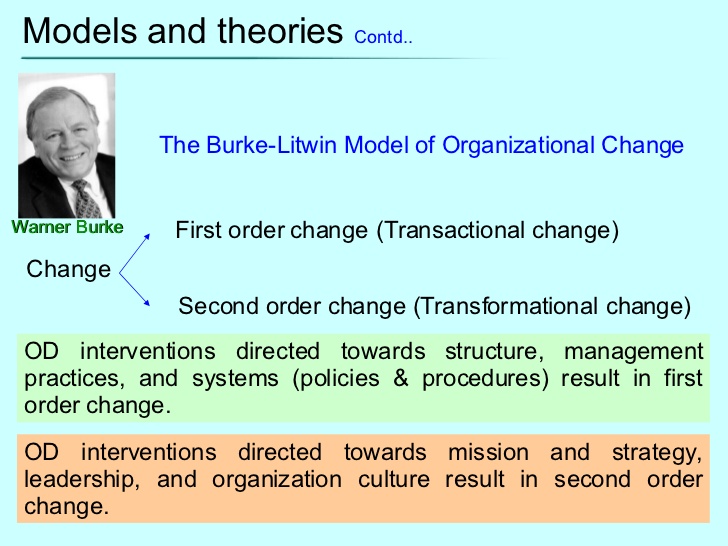- Faculty of Engineering and Information Technology
- 12 Change Mgmt Burke-Litwin
Org. Devel. & CHANGE Mgmt.
Org. Devel. & CHANGE Mgmt.
-
12. 12 Change Mgmt Burke-Litwin
The Warner Burke & George Litwin Organization Change Mgmt. Model
OD is a Planned process of change in an organization's culture through the utilization of Behavioral Science, Technology, Research and Theory

- First Order ... Transactional Change
- Second Order .... Transformal Change.
The next model to be examined is the Burke - Litwin model of individual and organizational performance, developed by Warner Burke and George Litwin. This model shows how to create first-order and second-order change (which the authors call “transactional change” and “transformational change”). In first-order change, some features of the organization change but the fundamental nature of the organization remains the same. First-order change goes by many different labels: transactional, evolutionary, adaptive, incremental, or continuous change. OD programs are directed toward both first – and second – order change, with an increasing emphasis on second-order, transformational change.
Org. Climate & Org. Culture
The model distinguishes between organizational climate and organizational culture. Organizational climate is define as peoples’s perceptions and attitudes about the organization – whether it is a good or bad place to work, friendly or unfriendly, hard working or easygoing ,and so forth. These perceptions are relatively easy to change because they are built on employees’ reactions to current managerial and organizational practices. On the other hand, organizational culture is defined as deep-seated values, assumptions, and beliefs that are enduring, often unconscious, and difficult to change. Changing culture is much more difficult that changing climate. The premise of the Burke-Litwin model is this: OD interventions directed toward structure, management practices, and systems (policies and procedures) result in first-order change; interventions directed toward mission and strategy, leadership, and organization culture result in second-order change.
Transactional & Transformational Leadership Style
The model also makes a distinction between transactional and transformational leadership styles. These two concepts come from leadership research which found that some leaders are capable of obtaining extraordinary performance from followers while other leaders are not. Transformational leaders are “leaders who inspire followers to transcend their own self-interested for the good of the organization and who are capable of having a profound and extraordinary effect on their followers”. Transformational leadership embodies inspiration which leads to new heights of performance. Transactional leaders are “leaders who guide or motivate their followers in the direction of established goals by clarifying role and task requirements”. Transactional leadership embodies a fair exchange between leader and follower that leads to “normal” performance. Transactional leadership is sufficient for causing first-order change.
-
Chapter Zero
-
T1 Organization Effectiveness.
-
T2 Org Stakeholders Manager & Ethics
-
T3 Org. Design Challenges
-
T4 Org-Structure Authority-Control
-
T5 Organization Culture "Org. Dynamics"
-
6 Org. Environment "Org. Dynamics"
-
Formal & Informal Organizations
-
OD Process - Action Research
-
OD Practitioner, Change Agent
-
Resilient Org المؤسسة المنيعة
-
11 Change Mgmt Kurt Lewin's 3 steps Model
-
13 Change Mgmt Kotter's Model
-
14 ADKAR Change Model
-
Other Change Mgmt Models
-
Next Generation Org
-
Diffusion of Innovation
-
Quizzes
-
Section 19
-
Assignments
